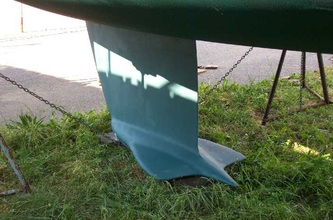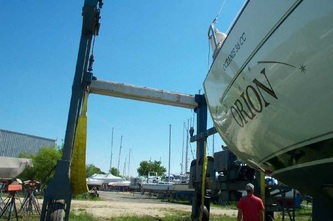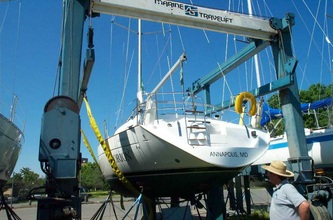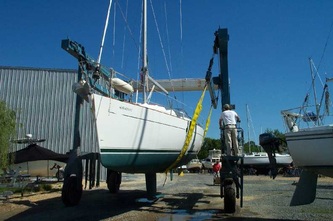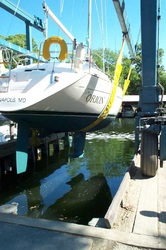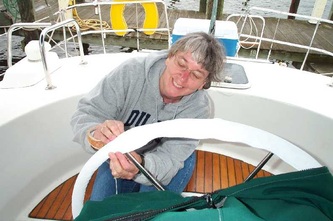
Cathy heads up the mast
We’re only a week away from leaving the security of our slip at Hospitality Harbor and sailing off to parts unknown. We have been rapidly completing projects on board, but it’s becoming apparent that we will not finish all that we have on our list before we loosen the dock lines on our slip for the last time next week. (Of course, most people say that you never complete everything on your list.)
Engine troubles
Without a doubt, the most important repair was fixing the engine so that it started reliably on the starting battery. After the experience in the haulout slip, David took the starting battery back to the store and was given another (this is the 3rd) new battery. With the new starting battery installed and fully charged, we headed out for a short sail, only to discover the brand new battery wouldn’t re-start the engine as we prepared to return. Receiving advice from a number of other mariners, David examined all the connections, but found no issues. We asked John Olivier, our “captain” from our first voyage and an electrician, to review the electrical system. He determined that the starter was getting 390 amps and still not starting. (It needs about 200 amps.) That meant a new starter needed to be installed. We arranged with the marina next door to install a rebuilt one the next day, and the engine has started without fail ever since. (Hurray!)
It’s Electric!
Even before the starter problems, David had planned to make several enhancements to the electrical systems. First, he upgraded the batteries by adding 2 new Trojan T105 6-Volt golf cart batteries to the house bank. This increased the available power by 225 amps, doubling the existing house bank capacity. Another related project was to install a 55 amp Iota Battery charger, which should now allow the generator to recharge the expanded battery banks in about 2 hours. We haven’t been able to test that yet, because we haven’t yet fired up the generator, but more about that later. The last, significant upgrade was to install a Xantrex Link 20 battery monitor. We benefited from John Olivier’s expertise and tools during his visit for this project, when he assisted Dave in installing the battery monitor wiring connections. (This required some thick wires, e.g. 1-0 gauge, which requires bolt cutters to cut.) With the monitor in place, we can see when each battery is charging, and, more importantly, when we’re not plugged in, how much current is being drawn and how many projected amp hours are remaining. Christmas came early when David saw the display light up and he was checking each device to see the current draw. (However, Cathy is thinking this may turn out to be “too much information”, envisioning arguments about whether we could “afford” to turn on the fan in the oppressive Chesapeake summer heat.)
Black water
One of the dirty little (or not so little) secrets about our boat was the abysmal state of the water tanks. We discovered this late last year, when we were cleaning out the starboard tank in preparation for winterization. “Disgusting” is too kind a word. It’s a good thing we had decided early on not to drink it. However, not drinking the water this year is not an option. While we could easily clean out the starboard tank through a large clean-out hole, the V-berth tank had no such access, but we were pretty sure we knew how bad it was. We solved this problem by cutting a new 6” clean-out hole, and then Cathy carefully cleaned the top and sides as we had done for the other tank last year. That was only the first step. We then needed to purify the whole system. According to research David had done on the web, this required putting a strong bleach solution in the tanks and letting it sit for several hours. Ideally, we could have gone for a sail to “stir” the tanks. Given the state of our engine this wasn’t an option, so David did his part by rocking the boat periodically. We flushed this water out and then refilled the tanks. In theory, it should be OK to drink. However, neither of us has been brave enough to try it yet. We did give some to a visiting dog however. She seemed to fare well . . .
Up, up, up . . .
Another mountaintop experience awaiting one of us was a trip up the mast to install a new LED light bulb in the anchor light and to fix the wind speed anemometer. We had purchased an ATN Top Climber for this purpose, which allows a person to climb the mast without someone else winching them up. Using a 2 clutch system, similar to that which mountain climbers might use, the person stands up in stirrups, slides the top clutch up, sits down on a seat to raise your legs and moves the bottom clutch up. (The guy at the boat show did this with amazing agility.) The weather was calm, but overcast as we readied the Top Climber for use. We carefully read the instructions, ran the rope through the clutches and hooked it into the spare spinnaker halyard. Then, it became apparent that each of us had been assuming the other was the going to be the first one up the mast.
Ooops.
Cathy lost the coin toss and began a much less agile climb up the mast than the salesperson demonstrated last year. Also, although this was done on a quiet day at the marina, it’s amazing how many people were there to witness and comment on the trip. After 20 minutes of effort and a lot of swearing, Cathy was at the top of the mast.
The first job of replacing the LED light bulb ended in failure when she discovered the bulb was twice as tall as the existing anchor light bulb, not allowing the lens to be screwed back on. There were also differences in the base (2-contacts for the LED light vs. 1 for the original). Something was seriously wrong. Later, at ground level, we determined that we had based our specifications for the new light bulb on an existing spare bulb that went into a different fixture. The good news was that the mast head light required only 10 watts of power, which meant a significantly less load on the batteries, using the existing incandescent bulb. First Star agreed to replace the base with a single contact version if we could find a lens tall enough to accommodate it. We are still working on this.
Turning from this frustrating failed project as the winds started to rise, Cathy turned her attention to the non-working anemometer. “All” we had to do was tighten a screw with an allen wrench. Fumbling through the bag for the correct size allen wrench and praying the predicted storms wouldn’t arrive early, she found the right size and even the right screw to tighten. It was loose, as predicted. Cathy tightened it, while David stood at the helm, hoping to see the wind speed magically appear.
Nothing.
Apparently, the screw tightening maneuver wasn’t the problem. As the rain clouds gathered, we tried to determine what might be the problem. Cathy unscrewed the transducer to get a glimpse of the wires underneath, but it didn’t’ reveal much. This would also require more work. Argh!
The last task was to measure the height of the mast to ensure we knew our clearance for sailing under bridges. Cathy dropped the tape measure to the deck to get a measurement. Since she couldn’t quite reach the top of the antenna, we had to make a guess based on what could be measured.
Although the trip back down was much easier than that up, it was still much slower than advertised, and the rain drops were starting to fall as Cathy reached the safety of the deck. Whew! But now she had a great story to tell.
You can never be too safe
While our boat was waiting for engine repairs, we did a little sailing on Don’s (David’s cousin) sailboat. Don noted the presence of the Coast Guard in the area, and the increased likelihood of being stopped for a safety check in the busy Patuxent River corridor. He explained that this could be avoided by having an inspection done and a sticker placed on the boat indicating such. David contacted the Power Squadron about having this done. The inspector spent over an hour with us one weekend morning, checking over both the sailboat’s and the dinghy’s safety equipment. (This was motivation to get the dinghy inflated as well.) He was impressed with our overall preparedness and we were able to earn our stickers for both vessels. This is a wonderful service provided by a completely volunteer organization.
Into the water
If our plan of anchoring out a lot of the time was going to be possible, we needed a functioning dinghy. This meant we had to put it in the water and power up the motor that had been taking up space in a box down below. With Don’s help, David launched the dinghy and prepped and mounted the 4HP Mercury outboard motor on the transom. With a couple of pulls, the engine started up with a surge, sending David overboard into the water. Having not attached the safety lanyard to himself, the engine kept running sending the dinghy in circles while David and Don struggled to regain control of it. Now, David religiously puts the safety lanyard on. We probably should have lost our safety sticker for that one.
Can you hear me now?
The VHF radio that came with the boat could only be used by someone at or close to the nav station down below. This meant that we tended not to monitor channel 16 or the weather as religiously as we probably should. To correct this, David purchased a Standard Horizon Intrepid VHF Radio plus RAM Microphone, which would allow us to have access to the radio via a mike at the helm. In addition, it is DSC capable, meaning we can place a distress call with a digital signature that includes a unique identifier for the boat and (due to an interface with the GPS) our position. The trickiest part about this upgrade was fishing the wires through from the engine to the nav station. Adding the cable for the remote mike (in addition to the battery monitor wires), has pretty much max’ed out the available space. However, the mike works great!
Friendly Folks
We’re getting to know a few of the permanent slipholders on our dock, as well as meeting some interesting cruisers who have spent a number of days here. Our immediate neighbors, Chris and Margaret, are a young couple about a year away from moving on board and cruising full time. Having just sold their home, their 35’ Beneteau is their home for the summer. Chris commutes to his job in Bethesda, while Margaret spends her days working on various boat projects. They plan to take an apartment for the winter and then move aboard full time next spring. We’ve been learning a lot from each other.
On Memorial Day weekend, David was pleasantly surprised to greet Mike, a former co-worker from the Corporation for National & Community Service, who had docked almost immediately across from us along with 5 other couples. The group had traveled from Occoquan in Virginia to spend the holiday weekend in Solomons. We enjoyed talking to them over the weekend and comparing notes on power boats vs. sailboats. (They were all power boaters.) We couldn’t get over the coincidence of meeting that way. Odds are if they had been one dock over, we would never have realized they were even there.
Another interesting cruising foursome arrived by trawler, docking at the end of the pier for about a week. They were traveling from Georgia north, making the “Great Loop”, which would take them up through the Hudson to the St. Lawrence, through the Great Lakes and down the Mississippi. They described some interesting towns visited so far, and gave us pointers about cruising guides and docking vs. anchoring. Based on discussions with them, we finally decided that we needed to get some folding bikes for the boat.
Sails up!
With the engine fixed, we are ready to sail. We’ve been out a number of times with varying amounts of wind and an assortment of guests. The Patuxent river is wide at the entrance to Solomons, so it’s possible to start sailing shortly after leaving our slip. Each trip has been a welcome break from all of the work to get ready and allowed us to dust the cobwebs off our sailing skills. Then, of course, there’s the practice of getting the boat back in the slip. It will still be a challenge to be ready to leave in a week, but we’re working our way down the list.
Engine troubles
Without a doubt, the most important repair was fixing the engine so that it started reliably on the starting battery. After the experience in the haulout slip, David took the starting battery back to the store and was given another (this is the 3rd) new battery. With the new starting battery installed and fully charged, we headed out for a short sail, only to discover the brand new battery wouldn’t re-start the engine as we prepared to return. Receiving advice from a number of other mariners, David examined all the connections, but found no issues. We asked John Olivier, our “captain” from our first voyage and an electrician, to review the electrical system. He determined that the starter was getting 390 amps and still not starting. (It needs about 200 amps.) That meant a new starter needed to be installed. We arranged with the marina next door to install a rebuilt one the next day, and the engine has started without fail ever since. (Hurray!)
It’s Electric!
Even before the starter problems, David had planned to make several enhancements to the electrical systems. First, he upgraded the batteries by adding 2 new Trojan T105 6-Volt golf cart batteries to the house bank. This increased the available power by 225 amps, doubling the existing house bank capacity. Another related project was to install a 55 amp Iota Battery charger, which should now allow the generator to recharge the expanded battery banks in about 2 hours. We haven’t been able to test that yet, because we haven’t yet fired up the generator, but more about that later. The last, significant upgrade was to install a Xantrex Link 20 battery monitor. We benefited from John Olivier’s expertise and tools during his visit for this project, when he assisted Dave in installing the battery monitor wiring connections. (This required some thick wires, e.g. 1-0 gauge, which requires bolt cutters to cut.) With the monitor in place, we can see when each battery is charging, and, more importantly, when we’re not plugged in, how much current is being drawn and how many projected amp hours are remaining. Christmas came early when David saw the display light up and he was checking each device to see the current draw. (However, Cathy is thinking this may turn out to be “too much information”, envisioning arguments about whether we could “afford” to turn on the fan in the oppressive Chesapeake summer heat.)
Black water
One of the dirty little (or not so little) secrets about our boat was the abysmal state of the water tanks. We discovered this late last year, when we were cleaning out the starboard tank in preparation for winterization. “Disgusting” is too kind a word. It’s a good thing we had decided early on not to drink it. However, not drinking the water this year is not an option. While we could easily clean out the starboard tank through a large clean-out hole, the V-berth tank had no such access, but we were pretty sure we knew how bad it was. We solved this problem by cutting a new 6” clean-out hole, and then Cathy carefully cleaned the top and sides as we had done for the other tank last year. That was only the first step. We then needed to purify the whole system. According to research David had done on the web, this required putting a strong bleach solution in the tanks and letting it sit for several hours. Ideally, we could have gone for a sail to “stir” the tanks. Given the state of our engine this wasn’t an option, so David did his part by rocking the boat periodically. We flushed this water out and then refilled the tanks. In theory, it should be OK to drink. However, neither of us has been brave enough to try it yet. We did give some to a visiting dog however. She seemed to fare well . . .
Up, up, up . . .
Another mountaintop experience awaiting one of us was a trip up the mast to install a new LED light bulb in the anchor light and to fix the wind speed anemometer. We had purchased an ATN Top Climber for this purpose, which allows a person to climb the mast without someone else winching them up. Using a 2 clutch system, similar to that which mountain climbers might use, the person stands up in stirrups, slides the top clutch up, sits down on a seat to raise your legs and moves the bottom clutch up. (The guy at the boat show did this with amazing agility.) The weather was calm, but overcast as we readied the Top Climber for use. We carefully read the instructions, ran the rope through the clutches and hooked it into the spare spinnaker halyard. Then, it became apparent that each of us had been assuming the other was the going to be the first one up the mast.
Ooops.
Cathy lost the coin toss and began a much less agile climb up the mast than the salesperson demonstrated last year. Also, although this was done on a quiet day at the marina, it’s amazing how many people were there to witness and comment on the trip. After 20 minutes of effort and a lot of swearing, Cathy was at the top of the mast.
The first job of replacing the LED light bulb ended in failure when she discovered the bulb was twice as tall as the existing anchor light bulb, not allowing the lens to be screwed back on. There were also differences in the base (2-contacts for the LED light vs. 1 for the original). Something was seriously wrong. Later, at ground level, we determined that we had based our specifications for the new light bulb on an existing spare bulb that went into a different fixture. The good news was that the mast head light required only 10 watts of power, which meant a significantly less load on the batteries, using the existing incandescent bulb. First Star agreed to replace the base with a single contact version if we could find a lens tall enough to accommodate it. We are still working on this.
Turning from this frustrating failed project as the winds started to rise, Cathy turned her attention to the non-working anemometer. “All” we had to do was tighten a screw with an allen wrench. Fumbling through the bag for the correct size allen wrench and praying the predicted storms wouldn’t arrive early, she found the right size and even the right screw to tighten. It was loose, as predicted. Cathy tightened it, while David stood at the helm, hoping to see the wind speed magically appear.
Nothing.
Apparently, the screw tightening maneuver wasn’t the problem. As the rain clouds gathered, we tried to determine what might be the problem. Cathy unscrewed the transducer to get a glimpse of the wires underneath, but it didn’t’ reveal much. This would also require more work. Argh!
The last task was to measure the height of the mast to ensure we knew our clearance for sailing under bridges. Cathy dropped the tape measure to the deck to get a measurement. Since she couldn’t quite reach the top of the antenna, we had to make a guess based on what could be measured.
Although the trip back down was much easier than that up, it was still much slower than advertised, and the rain drops were starting to fall as Cathy reached the safety of the deck. Whew! But now she had a great story to tell.
You can never be too safe
While our boat was waiting for engine repairs, we did a little sailing on Don’s (David’s cousin) sailboat. Don noted the presence of the Coast Guard in the area, and the increased likelihood of being stopped for a safety check in the busy Patuxent River corridor. He explained that this could be avoided by having an inspection done and a sticker placed on the boat indicating such. David contacted the Power Squadron about having this done. The inspector spent over an hour with us one weekend morning, checking over both the sailboat’s and the dinghy’s safety equipment. (This was motivation to get the dinghy inflated as well.) He was impressed with our overall preparedness and we were able to earn our stickers for both vessels. This is a wonderful service provided by a completely volunteer organization.
Into the water
If our plan of anchoring out a lot of the time was going to be possible, we needed a functioning dinghy. This meant we had to put it in the water and power up the motor that had been taking up space in a box down below. With Don’s help, David launched the dinghy and prepped and mounted the 4HP Mercury outboard motor on the transom. With a couple of pulls, the engine started up with a surge, sending David overboard into the water. Having not attached the safety lanyard to himself, the engine kept running sending the dinghy in circles while David and Don struggled to regain control of it. Now, David religiously puts the safety lanyard on. We probably should have lost our safety sticker for that one.
Can you hear me now?
The VHF radio that came with the boat could only be used by someone at or close to the nav station down below. This meant that we tended not to monitor channel 16 or the weather as religiously as we probably should. To correct this, David purchased a Standard Horizon Intrepid VHF Radio plus RAM Microphone, which would allow us to have access to the radio via a mike at the helm. In addition, it is DSC capable, meaning we can place a distress call with a digital signature that includes a unique identifier for the boat and (due to an interface with the GPS) our position. The trickiest part about this upgrade was fishing the wires through from the engine to the nav station. Adding the cable for the remote mike (in addition to the battery monitor wires), has pretty much max’ed out the available space. However, the mike works great!
Friendly Folks
We’re getting to know a few of the permanent slipholders on our dock, as well as meeting some interesting cruisers who have spent a number of days here. Our immediate neighbors, Chris and Margaret, are a young couple about a year away from moving on board and cruising full time. Having just sold their home, their 35’ Beneteau is their home for the summer. Chris commutes to his job in Bethesda, while Margaret spends her days working on various boat projects. They plan to take an apartment for the winter and then move aboard full time next spring. We’ve been learning a lot from each other.
On Memorial Day weekend, David was pleasantly surprised to greet Mike, a former co-worker from the Corporation for National & Community Service, who had docked almost immediately across from us along with 5 other couples. The group had traveled from Occoquan in Virginia to spend the holiday weekend in Solomons. We enjoyed talking to them over the weekend and comparing notes on power boats vs. sailboats. (They were all power boaters.) We couldn’t get over the coincidence of meeting that way. Odds are if they had been one dock over, we would never have realized they were even there.
Another interesting cruising foursome arrived by trawler, docking at the end of the pier for about a week. They were traveling from Georgia north, making the “Great Loop”, which would take them up through the Hudson to the St. Lawrence, through the Great Lakes and down the Mississippi. They described some interesting towns visited so far, and gave us pointers about cruising guides and docking vs. anchoring. Based on discussions with them, we finally decided that we needed to get some folding bikes for the boat.
Sails up!
With the engine fixed, we are ready to sail. We’ve been out a number of times with varying amounts of wind and an assortment of guests. The Patuxent river is wide at the entrance to Solomons, so it’s possible to start sailing shortly after leaving our slip. Each trip has been a welcome break from all of the work to get ready and allowed us to dust the cobwebs off our sailing skills. Then, of course, there’s the practice of getting the boat back in the slip. It will still be a challenge to be ready to leave in a week, but we’re working our way down the list.


